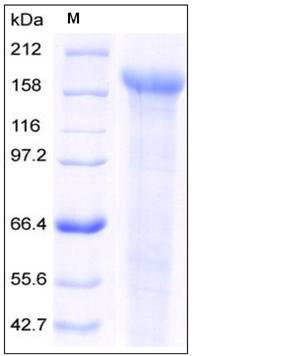Human JAG1 / Jagged 1 / CD339 Protein (His Tag)
AGS,AHD,AWS,CD339,HJ1,Jagged 1,JAGL1
- 100ug (NPP1625) Please inquiry
| Catalog Number | P11648-H08H |
|---|---|
| Organism Species | Human |
| Host | Human Cells |
| Synonyms | AGS,AHD,AWS,CD339,HJ1,Jagged 1,JAGL1 |
| Molecular Weight | The recombinant human JAG1 consists of 1024 amino acids and has a predicted molecular mass of 112 kDa. In SDS-PAGE under reducing conditions, the apparent molecular mass of rh JAG1 is approximately 160-180 kDa due to glycosylation. |
| predicted N | Gln 34 |
| SDS-PAGE |  |
| Purity | > 85 % as determined by SDS-PAGE |
| Protein Construction | A DNA sequence encoding the human JAG1 (NP_000205.1) extracellular domain (Met 1-Ser 1046) was expressed, fused with a polyhistidine tag at the C-terminus. |
| Bio-activity | Measured by the ability of the immobilized protein to enhance BMP2-induced alkaline phosphatase activity in C3H10T1/2 mouse embryonic fibroblast cells. The ED50 for this effect is typically 4-20 μg/mL. |
| Research Area | Immunology |Signal Transduction |Notch Pathway |
| Formulation | Lyophilized from sterile PBS, pH 7.4 1. Normally 5 % - 8 % trehalose, mannitol and 0.01% Tween80 are added as protectants before lyophilization. Specific concentrations are included in the hardcopy of COA. |
| Background | Protein Jagged 1, also known as JAG1, JAGL1 and CD339, is a single-pass type I membrane protein which contains 1 DSL domain and 15 EGF-like domains. JAG1/Jagged 1 is widely expressed in adult and fetal tissues. The expression of JAG1/Jagged 1 is up-regulated in cervical squamous cell carcinoma. JAG1/Jagged 1 is also expressed in bone marrow cell line HS-27a which supports the long-term maintenance of immature progenitor cells. JAG1/Jagged 1 is a ligand for multiple Notch receptors. It is involved in the mediation of Notch signaling. JAG1/Jagged 1 may be involved in cell-fate decisions during hematopoiesis. |
| Reference |
|
